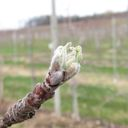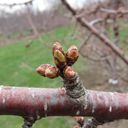Contents
- Current (through April 18) degree day (DD) Accumulations
- Current bud stages
- Upcoming meetings
- The way I see it
- 2011 New England Tree Fruit Management Guide Available
- Scale control options
- Pre-bloom nutrient sprays
- Useful links
Current (through April 18) degree day (DD) Accumulations
Location: UMass Cold Spring Orchard (CSO), Belchertown, MA
Base 43: 123
Base 50: 22
Significant upcoming orchard events based on degree days (Base 43):
Pear psylla 1st oviposition: 40-126
Redbanded leafroller 1st catch: 108-174
Spotted tentiform leafminer 1st catch: 113-199
McIntosh green tip: 95-147
Current bud stages
| Location | McIntosh apple -- early half-inch green | Gold Bosc pear -- swollen bud |
Burgundy (Pearl) cherry -- swollen bud | PF14 Jersey peach -- swollen bud |
| Belchertown UMass CSO (04/18/11) |
 |
 |
 |
 |
Upcoming meetings
April 19, 20: Tree fruit twilight meetings
Tuesday, April 19 -- Pine Hill Orchards, 248 Greenfield Rd., Colrain, MA
Wednesday, April 20 -- Tougas Farm, 246 Ball St., Northboro, MA
note: April 20 in collaboration with Rhode Island Fruit Growers' Association -- Rhode Island fruit growers are encouraged to attend!
Tree fruit twilight meetings start promptly at 5:30 PM. 1 (one) pesticide recertification credit will be offered. There will be a $25 meeting admission charged at the door. ($20 for Massachusetts and Rhode Island Fruit Growers' Association FULL members.) A light meal or snack will be served at all meetings. For more information, call Jon Clements: 413-478-7219, or Heather Faubert: 401-847-2967.
May 17, 18, 19: Tree fruit twilight meetings
June 14, 15, 16: Tree fruit twilight meeting
July 18, 2011: Massachusetts Fruit Growers' Association Summer Meeting, Parlee Farms, Tyngsoboro, MA
The way I see it
I repeat -- what a difference a year makes! Last year McIntosh was at full pink and cherries were in bloom on this date. We are getting to the point of -- dare I say it? -- late. That bodes well for frost issues (less chance of frost as season progresses), however, I always say it "all depends when the frost comes." (I know, cup is half-empty.) Getting apple scab sprays on has been a bit challenging with the wind, however, according to NEWA there have already been 2 apple scab infection periods @Belchertown since green tip.
If you are planting trees, keep these tips in mind:
- don't plant when the soil is too wet, but plant as early as possible
- soak tree roots in water for 24-48 hours before planting
- make sure graft union is 4-6 inches above ground for hi-density (tall spindle) apple plantings; all others apples and dwarf cherries plant graft union 2 inches above ground level; peaches plant graft union at ground level
We hope to see you at one of the 2 twilight meetings this week.
JC
2011 New England Tree Fruit Management Guide available
As a reminder, the 2011 New England Tree Fruit Management Guide is available for purchase here:
http://www.umass.edu/fruitadvisor/2011/2011netfmg.html
The 2011 New England Tree Fruit Management Guide (NETFMG) is available NOW. For $50 you will receive the printed guide by postal mail. You can download and print a mail-in form to order the NETFPMG by personal check here.
Note that for 2011 the herbicide/weed control section has been completely revised, and all sections have been carefully reviewed for changes in 2011. Order yours today!
Also note that Commonwealth Quality produce certified growers should have the 2011 NETFMG in their possession to achieve the maximum score!
Scale control options
San Jose scale seems to have become more problematic in recent years. I have excerpted from a recent (April 18, 2011) Scaffolds Fruit Journal article by Peter Jentsch the control options for scale. For the complete article, which is very good, click here.
Pre-bloom (up to half-inch green) is the most effective timing for treating scale. Oil, Lorsban, Supracide 25-W, and Esteem 35WP are options at this timing.Thorough coverage with oil is essential, and the earlier timing (green tip) the better. The addition of the other chemicals with oil has dubious value. (I.e., oil alone is very effective at controlling scale as long as good coverage is achieved.)
Early post-bloom where Provado, Esteem, and Assail are commonly used to control scale. Control during this period will be more difficult to achieve than during the pre-bloom period. New scale products which warrant trying during this period include Movento 240SC and Centaour 0.7WDG.
Late post-bloom chemical treatment options are the same as above (early post-bloom), however, timing is critical using a degree-day model. See the above-mentioned article for details.
JC
Pre-bloom nutrient sprays
The addition of urea (N), zinc, boron and magnesium to pre-bloom sprays has been shown to improve fruit set and quality of apple. Most progressive apple growers apply these sprays religiously before bloom. Here are some specific recommendations:
Urea (N) -- use 2-3 lbs. spray-grade urea per acre at pink and again at bloom.
Zinc (Zn) -- use 1 to 1-1/2 quart per acre most formulated zinc products (Sysstem Zinc, etc., see label for specific directions) at tight cluster to pink
Boron (B) -- apply 1 qt liquid boron (Solubor, Borosol, etc.) per acre at first bloom
Magnesium (Mg) -- not typically applied at this time, but Mg demand is high pre-bloom; apply liquid Mg formulation per label recommendation (for example Sysstem Mg at 1 qt. per acre)
For more information, see: UMass Fact Sheet F-126 Prebloom Nutrient Recommendations for Apples or Rutgers Plant & Pest Advisory Apple Foliar Nutrient Suggestions for 2010
JC
Useful links
UMass Fruit Advisor http://www.umass.edu/fruitadvisor/
Scaffolds Fruit Journal http://www.nysaes.cornell.edu/ent/scafolds/
Network for Environment and Weather Applications (NEWA)
JMCEXTMAN Blog http://jmcextman.blogspot.com/
Follow me on Twitter http://twitter.com/jmcextman and Facebook http://www.facebook.com/jmcextman
